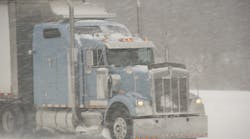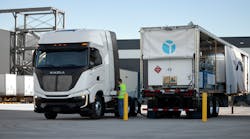Cold weather can challenge engines to start and can cause engines to operate in a variety of ways. In particular, there are three critical challenges fleets face when it comes to dealing with engine issues in cold weather.
The first challenge is that the engine must overcome additional temperature rise to achieve the ignition of diesel fuel.
The second issue involves unwanted fuel gelling and ice crystals forming in fuel. Both can lead to plugged filters and engine shut down. Treatment of fuel can be inconsistent when dealing with rapid changes in temperature.
The third issue is reduced cold cranking amps of the battery. Cold cranking amps are required to power starting aids such as air intake heaters, glow plugs and power to the starter.
To prevent these issues ahead of the winter months, fleets should consider preparing before the weather turns cold.
Reduce maintenance and customer impact
Costs associated with unexpected roadside truck breakdowns range from requiring jump starts to requiring tows for expensive service visits. Not to mention, the added cost of missing on-time delivery to customers and the lost time for drivers not on the road.
Having cold weather equipment installed on fleet trucks during regularly scheduled maintenance in late summer or fall will reduce the number of additional service visits during the winter. Fall maintenance becomes more critical for older trucks as they age, and as parasitic loads are added to the engine, as both make engines more difficult to start.
Another benefit to planning ahead in the summer and fall months is that parts are in stock without the requirements of overnight freight due to a being truck down.
Essential cold weather equipment
The essential equipment fleets require will be dependent on where the trucks operate; the colder it gets, the more equipment they will have.
Block heaters
Block heaters help the engine achieve combustion temperature, relieve engine stress and reduce engine wear. The warm coolant in the engine also provides heat to the cab faster to keep drivers comfortable.
For trucks that have a block heater already installed, complete a continuity check to ensure it’s ready for the winter. Fleets can extend the life of the block heater by making sure coolant levels are topped off and the system is bled of air prior to running the block heater. Use a 50/50 coolant mixture and avoid no-coolant system sealants. Most importantly, don’t plug in the heater while the engine is running.
Thermostats
Adding a thermostat will allow for increased energy savings. The thermostat keeps an engine in a selected temperature range, turning the block heater on and off to save energy consumption and unnecessary costs. With a thermostat, the question of when to plug in the heater is simplified. Plugging in the block heater and the thermostat will control heater operation.
Oil pan heaters
Oil pan heaters are designed to maintain oil temperature, and should be used in addition to block heaters in extremely cold weather applications. Oil pan heaters aid in cold starts and improved engine lubrication. Purchase a parallel Y-cord to ensure the oil pan heater and block heater are running at the same time.
To extend the life of oil pan heaters, plug in the unit while the engine is still warm.
Battery warmers
Batteries can lose 35 to 60 percent of their power in cold weather. Battery warmers keep truck batteries at operating temperatures which also maintains the batteries’ cold cranking amps. Cold cranking amps are critical to power cold start aids and the starter.
Fuel warmers
Fuel gelling is a common problem for fleets during cold months, and especially during rapid freezes early in the season. Additionally, free water in diesel freezes can lead to the formation of ice crystals causing abrasive wear to fuel systems. Both gelled fuel and ice crystals can block filters, preventing fuel flow and leading to engine shut down.
There are products available that use warm engine coolant to prevent gelling and ice, reduce dependency on additives and help prevent shut downs at extremely low temperatures (e.g. -40 degrees F).
It is important to assess the needs of a fleet before weather gets cold. Consider winterizing trucks during a fall preventative maintenance schedule to save on maintenance costs and reduce costly downtime.
Based in Eden Prairie, Minnesota, Phillips & Temro Industries provides thermal and electrical products for on- and off-highway applications, under the following brands: Zerostart/Temro, Arctic Fox, Truflo and Idle Free Systems. Bremhorst is the director of heavy duty and power systems at Phillips & Temro Industries.




